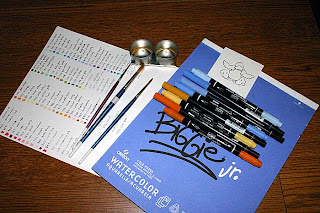 I decided to try giving my first online tutorial. It was not easy because so much of the stuff is just easier to show in person! Since I have had a lot of comments on my water coloring, I decided to start there. I'm almost embarrassed about how easy it is. Marker water coloring is not water coloring in the true sense of the word! You use some of the same techniques, but that's about it. It is easy for anyone to learn, and the results are instant and dramatic!
I decided to try giving my first online tutorial. It was not easy because so much of the stuff is just easier to show in person! Since I have had a lot of comments on my water coloring, I decided to start there. I'm almost embarrassed about how easy it is. Marker water coloring is not water coloring in the true sense of the word! You use some of the same techniques, but that's about it. It is easy for anyone to learn, and the results are instant and dramatic!I decided to choose a simple image for part 1. A little later down the road, I will do a part 2 with a more complex image and background. As you can see, you need a decent watercolor paper, I use Biggie Jr. by Canson. It is cheap, 50 pg. for 10.00 dollars and I purchase it at my not so local fine art store. Not all watercolor papers are created equal in the case of marker watercolors. Some papers have the ink soak in too fast making it impossible to move the color! The second item you need is water based markers. I use Tombow and Stampin'Up! markers which are excellent quality and highly pigmented. Again bold color gives you bold results, and though expensive, these markers are worth it! Finally you need some good brushes and water resistant ink! I use artist quality sable brushes. These are mine from when I did watercolor. They are 20 years old and still going strong. I use small rounded brushes up to large rounded brushes, each one sized for different job's. I also use flat blunt tipped brushes for doing the occasional washes. Last my ink is Memories dye ink pad which resists smearing with water. I have Staz-on but use it rarely due to the habit it has of staining my rubber. In the picture you will also see a chart I have made with a scribble and a name and number of each marker that I own. This makes it easy for me to find the right color, The cap rarely gives a true representation of the color.
Before I start my initial coloring, I look at the image and try to determine what colors I will need. I usually choose 3 colors in each needed value. For instance the beak, I will use A light, a medium and a dark. I chose for this a pale yellow, medium orange, and a orange/red . All colors which are used to form each other.
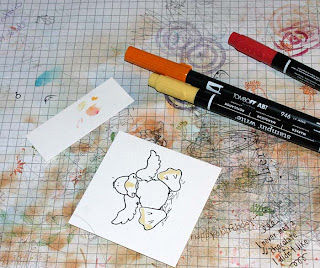 I start by working in sections. It is often advisable when you start to do small sections at a time. This is because you may be more hesitant and take more time letting the ink on other sections sink in and become less movable. I start by laying down the lightest color in a scribble in the areas I think should stay lighter. You can also leave these areas blank to allow a thin wash of your darker color to cover.
I start by working in sections. It is often advisable when you start to do small sections at a time. This is because you may be more hesitant and take more time letting the ink on other sections sink in and become less movable. I start by laying down the lightest color in a scribble in the areas I think should stay lighter. You can also leave these areas blank to allow a thin wash of your darker color to cover.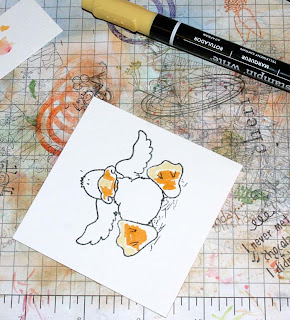 I add in my middle color, following the contours and areas I think should be shaded.
I add in my middle color, following the contours and areas I think should be shaded.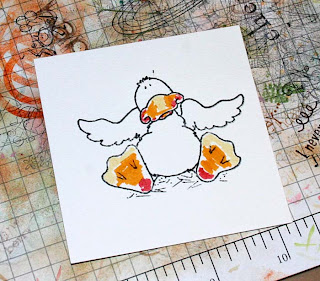 Last I add my darkest color. It is now ready to blend. Because the area is small I will choose a small brush for the area. I make sure the brush is not so wet that it drips, but not so dry that the bristles become separated. I usually use the back of my hand to determine the wetness.
Last I add my darkest color. It is now ready to blend. Because the area is small I will choose a small brush for the area. I make sure the brush is not so wet that it drips, but not so dry that the bristles become separated. I usually use the back of my hand to determine the wetness.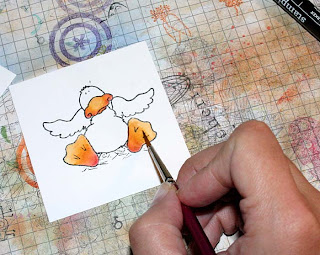
I work in a circular motion to get good blending. The circles I use are tight and controlled. My brush is held at approximately 45 degree angle. I hold lower down for control. I start in the light area, move down to the dark area, move back up to the medium area then clean off my brush so as not to darken my light value to much. I then take my clean brush and clean up the line between the medium and the light. Any mistakes can be fixed by adding a drop of water to the offending area, and soaking it up with a rag or Kleenex.
















 This next one is showcasing the cracked glass technique. Once again I drew on Adrea for inspiration. I
This next one is showcasing the cracked glass technique. Once again I drew on Adrea for inspiration. I



